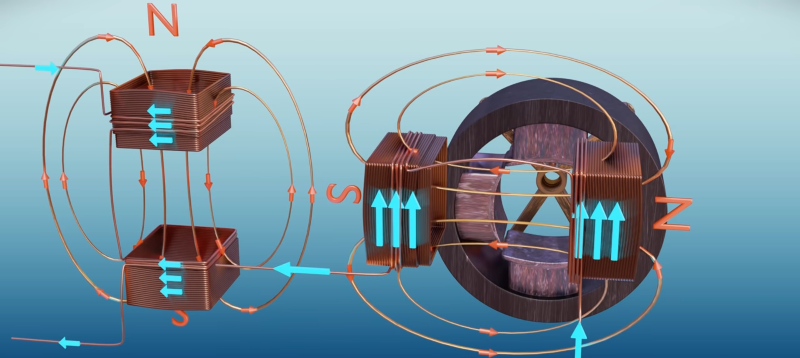If you made a motor out of a magnet, a wire coil, and some needles, you probably remember that motors and generators depend on a rotating magnetic field. Once you know how it works, the concept is pretty simple, but did you ever wonder who worked it all out to start with? Tesla figures into it, unsurprisingly. But what about Michael Dobrowolsky or Walter Bailey? Not common names to most people. [Learn Engineering] has a slick video covering the history and theory of rotating magnetic field machines, and you can watch it below.
Motors operated on direct current were not very practical at the time and caused a jerky motion. However, Tesla and another inventor named Ferraris realized that AC current could cause a rotating magnetic field without a moving commutator.
Tesla’s motor used two AC currents with a 90-degree phase difference produced by his two-phase generator. Ferraris used a single phase along with an inductor to create the phase difference. However, two-phase motors have limitations and Dobrowolsky’s three-phase design quickly replaced two-phase designs.
The video has many animations to help understand how motors work. It also explains why the magnetic poles of a motor winding appear opposite of the poles in a permanent magnet. Will you be ready to design the next super-efficient electric motor after watching this video? No. But you will have a better understanding of what really goes on inside an AC motor.
If you send electricity to a coil near a magnet, you can make a shaft rotate. If that shaft rotates a magnet and a coil, you get electricity. So, while not ideal, many generators can work as motors and vice versa. If you think the whole world runs on three-phase AC, you should read about the stubborn persistence of two-phase.
















Uh oh. Here they come. You’ve triggered the RodinOverunityTelsa wingnuts. Take cover.
Bit puzzled by the sentence ” So, while not ideal, many generators can work as motors and vice versa”.
Some questions: are there motors that cannot work as generators or vice versa? I thought it was quite a fundamental property. Also, why is it not ideal? How are they optimized differently?
A magneto won’t run as a motor because it has no commutation and only a single phase, so you can’t get it started.
You may rotate it up to synchronous speed somehow, and it will probably keep turning, but loading it up will drop it out of sync and stall it.
For the optimization of it: the induction motor first has to be started up as a motor, and then run at greater than synchronous speed to exhibit generator action. It may in some configurations be made to self-excite, but it won’t start generating just by turning it, and the voltage it makes goes all over the place. A real generator is made with controllable field current (slip rings for the rotor coil), so you can have voltage regulation independent of the frequency, and you can always start the generator.
Yes and No. If an asynchronous motor has recently been run, then it doesn’t have to be run as a motor first. Once you get it above synchronous speed, it will start generating. How recent depends on the individual motor. You just need enough residual magnetism left in the motor. Often this will also require capacitors across the lines.
And fairly sure a squirrel cage induction motor won’t work as a generator for similar reasons. Basically any motor or generator with some way to provide a magnetic field when stationary can work as both
Yes it will:
https://en.m.wikipedia.org/wiki/Induction_generator
Counterpoint: mopeds and other small motors without electronic^ ignition often have a generator with a permanent magnet sweeping past the ignition coil, making brief high voltage pulses. This cannot work as a motor because the coil cannot push the rotor all the way around.
^(“electronic” uses active elements, “electrical” means all passive components. Now you know the difference.)
I’d like to see the Little motor animation they had for Michael Dobrowolsky build in real life. It was a very pretty Moving sculpture. IMO
Now rotate that magnetic field around a superconductor. UFO appears! Where is Ning Lee?!
Here’s the link to the non-embedded YouTube video:
Understanding RMF | The driving force behind every AC machine
https://www.youtube.com/watch?v=wqrGHeuxUvI
https://www.youtube.com/watch?v=wqrGHeuxUvI